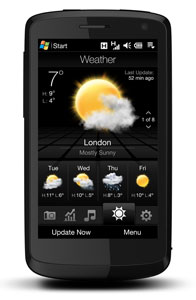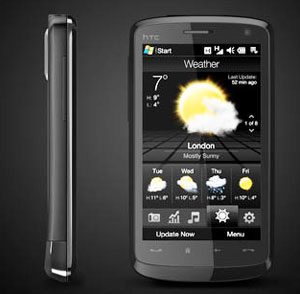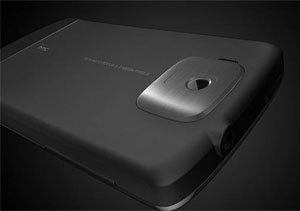
|
||||||||
Web Browsing The web browser in TouchFLO is Opera Mobile 9.5 and it is good; it's better in some respects than Safari on the iPhone though they are both based upon the same basic open source 'WebKit' engine. The Opera browser renders a few pages a little better, the bigger screen allows Opera to ease back on the compression in fact, many pages render without any compression, indeed in landscape mode, this phone's resolution is as wide as a PC was ten years ago and as wide as all web sites were five years ago. One notable difference; when Safari opens it extends the page vertically to shrink it horizontally; Opera didn't do that but rather zoomed out the page to fit, usually 90% of it on screen forcing some scrolling. Screen rotation is automatic; the integrated accelerometer detects the rotation however, it's not consistent, sometimes taking time to notice the change. Navigating the page and zooming is intuitive though a lack of multi-touch prevents the 'pinch' action used on iPhone to zoom. Links on the page are only active when zoomed in, so there's an extra step before you can click a link. A buzz from the vibration motor provides useful feedback when the link is hit. Flash is not supported but overall this phone is a capable web browsing device.
Phone, Data and Reception The model reviewed here is designed for the EU market where all is standards and light; the quad-band phone works on US networks and EDGE is available but the 3G radio is tuned for 900Mhz and 2100Mhz so skips over AT&T's 850Mhz and T-Mobile's 1700Mhz signals; oh dear. Still, Wi-Fi is everywhere I go and I'm not that hurt by EDGE data speeds when out and about. Normal phone call performance is satisfactory; the speakerphone works well and call set-up/clear down is prompt. Loud ring settings do cause the internal speaker to distort though. The phone dialer is able to use T9 to quickly find contacts in the contacts list; that's a plus. In use though, the phone doesn't enjoy that automatic ability to wake up when you move the handset away from your ear to give you the choices of call control like the iPhone does. As with the HTC Touch Diamond and Touch Pro, you must press the power button to turn on the screen. Bluetooth integration is faultless and extends to stereo audio. Multimedia With the option of replaceable microSD storage cards, the Touch HD offers more usable music and video storage than the iPhone; the operating system, applications and application storage resides on the internal ROM/RAM leaving the micro-SD 100% available. The integrated media player in TouchFLO is good; it offers direct playback of mpeg4 AVC/h.264 as well as WMV using the regular media player. Personal movie playback on the Touch HD is tremendous; the screen contrast, brightness and colour depth are first rate; better in fact than many dedicated personal video players. Music playback is equally well executed, again using the TouchFlo media player emulating the album cover view for media selection it plays all kind of media from MP3 to AAC to WMA with DRM.
The included FM Radio works, it needs the headset and doesn't work without it since it acts as the radio antenna. Sound quality is ok and it does work where a data signal (for online streaming radio) might not. Lastly, the ubiquitous YouTube is here, again a first class citizen of the TouchFLO interface. It offers the same enjoyable experience and tenancy to steal hours of productivity as the iPhone version. GPS Google maps or Windows Live Search at 800 x 480 resolution; very nice indeed. The experience offers a clearly wider field of view, ensuring that as you zoom in you don't lose the general feel of where you are. Acquisition time is sluggish, though positioning is very accurate once it does get a fix. The aGPS feature wouldn't kick in in my tests, so the phone had to make do with non-assisted GPS.
The main camera can also shoot video up to VGA resolution with audio. The front mounted VGA camera offers video calling if you can find a friend with the same feature (not going to happen in the US). Are you video calling? Apparently, according to recent research in Japan by eurotechnology.com where 60 Million 3G handsets exist... no one is doing it there. Battery The claim is 8 hours talk / 18 days standby on GSM. I wonder where they get these numbers from; really, I mean, in an anechoic, RF shielded chamber, with its own cell tower, with the battery overcharged and gently warmed and no sign of email sync... maybe... on a good day. Back in the real world; don't forget the charger; it'll like to see it daily as most smart phones do. An hour of surfing on the Wi-Fi link saw the battery depleted by 50%. At a stretch you might manage a weekend away but the simple load imposed by traveling might see it limping home with a bar of life left. Applications and under the bonnet The TouchFLO interface dominates the user experience. For the most part, the experience is OK and many activities can be carried out in the TouchFLO interface; media player, photo viewer, camera, SMS and email. You might expect, as I did, that the TouchFLO interface would be a bolt on program launcher and once you needed to do anything outside of it you'd be back in Windows Mobile world, well you, and I would be partially correct. It's more like a taste of what is to come in Windows Mobile, think of it as a sample release of Windows Mobile 7, it's not feature complete by a long way but you can do much of your work in this environment and it will please you to use it. When you do step out, Windows Mobile has evolved since I last used it (Windows Mobile 5) the apps are a little better and more polished but it is not iPhone or Android, it is more 'Blackberry functional' than 'iPhone slick'. There are no animations or cool controls. It is Windows desktop on a mobile device. Underneath the slick user interface is Windows Mobile Professional 6.1; I say underneath because if it were on top this review would be over. Microsoft has been outclassed by Apple, Google et al. on the UI front; they're in third or fourth place by a significant margin and they know it but the Redmond giant seems slow to turn. Microsoft will bring the OS up to date in version 7 and I suspect that they'll return to the top or at least close to the top but I'm left puzzled as to why they're not making the best of what they already have. Microsoft was first to the show with an open development environment where you could design and install your own stuff; they battled the mobile phone companies head on years ago. Why is Microsoft not shouting out from the roof tops about their open platform, the brilliant and free developer tools and where is the Microsoft Windows Mobile App store? Perhaps this will come with version 7 but I feel that it'll look like a 'me too' rather than a 'forget-the-rest'. Conclusion As a business proposition; it's ActiveSync and regular Windows Home Screen offer the usual fair but in very high resolution, as a consumer device, it's less appealing. It's a no win choice for me; I love the high resolution display but not the touch screen, the multi-tasking OS, unlike the iPhone offers app-to-app switching at lightning speeds but the regular slow-downs irritate. I like it, I want to love it, it is half finished, the half that is finished works well. The form factor is good for me, I like thin units over keyboards but typing is not as quick as the iPhone by a large margin. In some respects I'd wish I hadn't seen this device; it's a taste of 2009 and my appetite has been whet; my iPhone, whilst slick, could have a better screen I've seen it and I want it but I want it all. Roll on 2009. Pros
Price: Estimated $800 from online importers Web site: www.htc.com
| ||||||||






